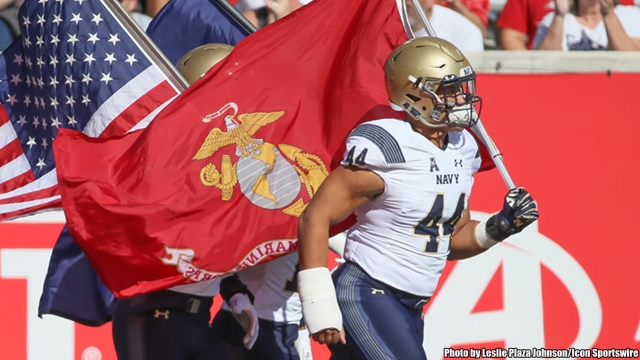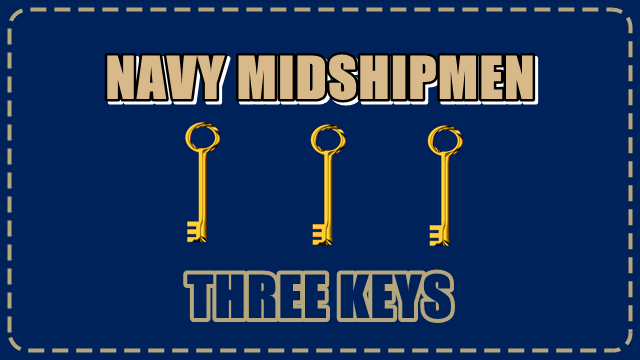
It was painful enough for Navy to lose again to Army, but it was even more painful to concede the Commander-In-Chief’s Trophy to the boys from West Point. Army hadn’t lifted the CIC since 1996, a point of pride in Annapolis (and also Colorado Springs for the Air Force Academy). How can Navy take back the most important trophy in service-academy football?
1) DISCIPLINE, DISCIPLINE, DISCIPLINE
The content of this message is not hard to grasp. The importance of this message is not hard to grasp. Yet, the seasons in which Navy football has struggled — 2011 and 2017 — involved a lack of discipline. In each of those seasons — when Navy failed to produce a winning record over the course of 12 regular season games — the Midshipmen piled up too many errors at the wrong times. The glory and success of the Ken Niumatalolo era have been built on the fact that Navy has so consistently sharpened its focus and elevated its level of play in fourth-quarter crucibles and tense scoreboard situations, but every now and then, that formula disappears. Last year, it did against Army in Philadelphia snow.
Malcolm Perry was the best player on the field in the 2017 Army-Navy Game. His performance should have been rewarded with a victory, and it probably would have if Navy hadn’t committed two false starts on the final drive, making Bennett Moehring’s kick in the snow that much more difficult. As we all know, Moehring hit one of the better kicks in his life, but the distance combined with the conditions led to a narrow miss. Had that very kick occurred 10 yards closer to the goal posts, it would have been good.
Coulda, shoulda, woulda — that is the lament of human beings who let golden opportunities slip away. Navy has been so good at seizing those opportunities in the decade Niumatalolo has been coaching this program, and the Mids have been so good at pouncing on those chances against Army in a number of very close games, but the last two years have involved those same small margins, and Navy has not stood on the right side of them.
Talking about discipline is easy. Demonstrating it — especially when it counts — is the hard part.
Navy has to be on the right side of small margins once again. The Mids might not always outplay their opponents, but they can’t donate yards, points and possessions to them, especially Army.
2) HIT THE BIG PASS WHEN IT’S THERE
Navy did this against Air Force. It did not do this against Army. That very simple summation could tell you the whole story about the need for this particular ingredient in a CIC Trophy formula, but let’s provide some more details and context.
Part of the runaway success of the Keenan Reynolds era was built precisely on the fact that Reynolds became very dependable at hitting the big pass when Thrivin’ Ivin Jasper dialed it up. Army, playing (wisely, it should be said) a more manageable independent schedule so that it can more regularly make bowl games each season, is in a better position to adopt Jeff Monken’s “run, run, run” plan and refuse to pass the ball. Navy, in a wide-open AAC with a lot of potent offenses, doesn’t have that luxury. Navy can’t keep the passing game under wraps entirely. It has to be able to find that 50-yard play — not only to reduce strain on Malcolm Perry and the running backs (Navy has endured a lot of quarterback and running back injuries over the past few years), but to also keep the offense diverse enough that the defense might hesitate at an important juncture in the game, which can make the difference in a close contest.
If Army played in the AAC, Monken — as much as his run-only philosophy has in fact worked — would probably also feel the need to diversify his offense. He can be more insistent on the running game against a number of the opponents Army plays. Against Mike Norvell at Memphis, McKenzie Milton and UCF, and the pass-happy offenses at SMU and Houston, the calculus which weighs scoring versus ball control moves in the direction of point production, which therefore makes it more important to have more tools in the toolbox. Navy’s offense, against teams such as Memphis and SMU, has to hold serve on a relatively consistent basis. It did exactly that in 2015 and 2016 (beyond the CIC games — those are overall references), and it also did its job against Air Force last season. Bringing that same potency to Colorado Springs and then to December against West Point will maximize Navy’s chances of once again commanding the CIC series.
3) A FUNDAMENTAL CONCEPT
Coaches love to talk about being stronger in the fourth quarter than the opponent. Coaches love to emphasize being tougher for 60 minutes. They revel in moments when they feel they can impress upon their players the importance of “finishing,” of driving to the end of the journey with more fuel in the tank, more fire in the belly, than the opponent. They love to establish a culture of resilience, of enduring physical and situational hardship to achieve a team goal. This is football motivation as we have seen it, heard it, and known it for so long.
This is not misplaced or misguided motivation. Football is an emotional sport, and it is an immensely — often dangerously — violent sport. Coaches need to cultivate a mindset in which players are fully prepared to handle all sorts of adversity: physical pain, scoreboard deficits, the frustration attached to a big mistake. Powering through those difficulties with a level head and a willing mind creates winning football teams. Coaches are not wrong to push this strand of motivation.
However, where coaches — including the best ones — go too far is in their insistence that games are won in the fourth quarter, to the exclusion of the first half. Pete Carroll, who has done it all in football — Super Bowl champion, college football national champion, Rose Bowl champion — is very fond of saying to his Seattle Seahawk players that games aren’t won in the first, second or third quarters, only in the fourth. To be sure, that mantra has carried the Seahawks a long way, but in recent years, the Seahawks’ offense has often sputtered in first quarters of games, creating uphill battles which made it harder for the team to thrive. Imagine if the Seahawks had spent 2017 not digging 10- or 14-point ditches for themselves. They might have made the playoffs and continued their run of success.
By all means, Navy has to master the small margins again, a point affirmed earlier in this column. Yes, Navy has to turn the tide against Army after two excruciatingly close losses. However, what if — gasp! — Navy doesn’t have to sweat bullets in the final minutes against Army or Air Force? What if, get this, Navy can execute crisply right out of the gate and get on top of the Black Knights and Falcons, such that it can carry a 14- or 17-point lead into the last 10 minutes of the fourth quarter? Last season’s defense didn’t play well against Air Force, but in a strong majority of its 13 games — 9 of them — Navy’s defense played more than well enough to win. The offense, however, was marked by chronic inconsistency and couldn’t dig its way out of trouble.
Teams with track records of success in prior years — teams accustomed to making that big play late in the fourth quarter — can assume that they will once again find that “big-moment magic” in a subsequent season, but the peril of that assumption is that sometimes, the big play doesn’t come. That is a big-picture way of expressing what happened to Navy last year, especially against Army. Navy did defeat Air Force with incredible plays at the very end, but that was a home game. This year’s contest is in the elevation of Colorado Springs. Chances are Navy will have to be far sharper than it was last year in order to beat the Falcons on the road.
Be ready to win the close game, but try to expand margins and improve the odds — that is something Niumatalolo can tell his players… in addition to being stronger in the fourth quarter.



